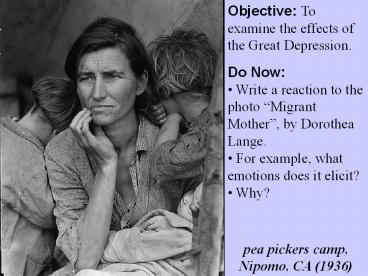Objective: To examine the effects of the Great Depression. - PowerPoint PPT Presentation
1 / 34
Title:
Objective: To examine the effects of the Great Depression.
Description:
Objective: To examine the effects of the Great Depression. Do Now: Write a reaction to the photo Migrant Mother , by Dorothea Lange. For example, what emotions ... – PowerPoint PPT presentation
Number of Views:323
Avg rating:3.0/5.0
Title: Objective: To examine the effects of the Great Depression.
1
Objective To examine the effects of the Great
Depression.
- Do Now
- Write a reaction to the photo Migrant Mother,
by Dorothea Lange. - For example, what emotions does it elicit?
- Why?
pea pickers camp, Nipomo, CA (1936)
2
The photograph that has become known as
"Migrant Mother" is one of a series of
photographs that Dorothea Lange made of Florence
Owens Thompson and her children in February or
March of 1936 in Nipomo, California. In 1960,
Lange gave this account of the experience
3
I saw and approached the hungry and desperate
mother, as if drawn by a magnet. I do not
remember how I explained my presence or my camera
to her, but I do remember she asked me no
questionsI did not ask her name or her history.
She told me her age, that she was thirty-two. She
said that they had been living on frozen
vegetables from the..
4
.. surrounding fields, and birds that the
children killed. She had just sold the tires
from her car to buy food. There she sat in that
lean- to tent with her children huddled around
her, and seemed to know that my pictures might
help her, and so she helped me. There was a sort
of equality about it. (From Popular
Photography, Feb. 1960).
5
Police stand guard outside the entrance to New
York's closed World Exchange Bank, March 20, 1931
6
Unemployed men vying for jobs at the American
Legion Employment Bureau in Los Angeles during
the Great Depression.
7
Unemployed workers in front of a shack with
Christmas tree, East 12th Street, New York City.
December 1937
8
(No Transcript)
9
Hard Times
Unemployment By the early 1930s,
approximately 25 of the nation was unemployed.
Man in hobo jungle killing turtle to make soup,
Minneapolis, Minnesota. Sept. 1939.
10
Families in Crisis
Marriage and birth rates dropped.
Fathers and some children left home to find
work.
11
Evicted family with belongings on street,
December 14, 1929.
12
Homelessness
Homeless families build shacks out of wooden
crates and scrap metal.
These shacks were known as Hoovervilles.
Seattle, Washington
13
Central Park, New York City
14
(No Transcript)
15
Hooverville," New York City, December 8
1930 Sign on shack reads "House of
Unemployed"
16
Brother, Can You Spare a Dime? (1932)
They used to tell me I was building a dreamAnd
so I followed the mob.When there was earth to
plow or guns to bear,I was always there, right
on the job.They used to tell me I was building a
dreamWith peace and glory ahead --Why should I
be standing in line, just waiting for bread?
Once I built a railroad, I made it run, Made it
race against time.Once I built a railroad, now
it's done --Brother, can you spare a dime? Once
I built a tower, up to the sun,brick and rivet
and lime.Once I built a tower, now it's done
--Brother, can you spare a dime?
17
Once in khaki suits, gee, we looked swellFull of
that Yankee Doodle-de-dum.Half a million boots
went slogging through hell,And I was the kid
with the drum. Say, don't you remember they
called me Al,It was Al all the time.Why don't
you remember, I'm your pal --Say, buddy, can you
spare a dime?
18
Hoover Takes Action
- At first, President Hoover was against offering
direct government relief.
- Instead, he asked private charities, such as the
YMCA, to help.
19
Christmas Day Breadlines in New York City, 1931
20
(No Transcript)
21
- Hoover eventually set up public works programs,
where the government hired people to construct
schools, dams and highways.
22
The Hoover Dam
23
(No Transcript)
24
- Hoover also approved the Reconstruction Finance
Corporation (RFC), which loaned money to
railroads, banks, and insurance companies.
Des Moines Register, April 5, 1930
25
(No Transcript)
26
The Bonus Army
- World War I veterans were due to be paid a bonus
in 1945.
- In 1932, over 20,000 jobless veterans protested
in Washington, D.C. demanding immediate payment.
27
(No Transcript)
28
(No Transcript)
29
(No Transcript)
30
Handpainted sign on Bonus Army truck states "We
Done a Good Job in France, Now You Do a Good Job
in America"
31
(No Transcript)
32
Tanks and cavalry prepare to evacuate the Bonus
Army (July 28, 1932)
33
The United States Army burned this and similar
camps to the ground after routing the many
thousands of protestors that were camped out in
the national capital with tanks, tear gas, and
troops of armed soldiers. (July 28, 1932)
34
- In clashes with police, four veterans were
killed.
- Hoover ordered General Douglas MacArthur to
clear out the veterans using cavalry, tanks, tear
gas and machine guns.
The brutal treatment of the Bonus Army
lowered Hoovers popularity even further. The
nation was poised for a new leader to lead them
out of the depression.
(concluding video 612)































